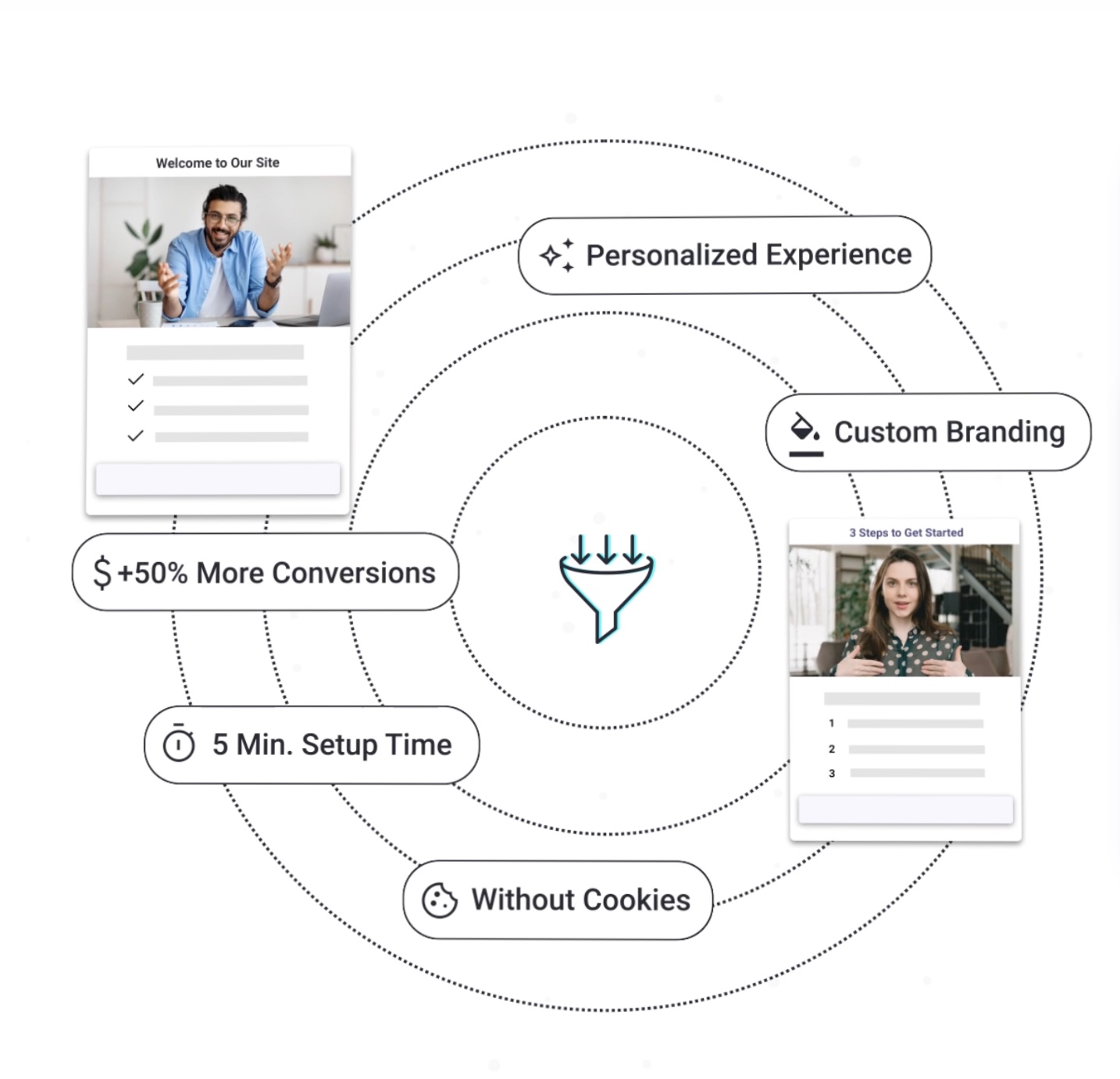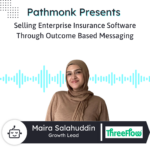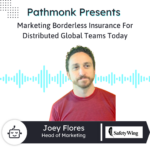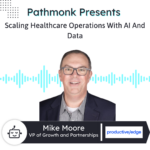
Introduction
In this insightful episode, we welcome Paul Chernin, Vice President of Marketing at Coriell Life Sciences.
Paul sheds light on how Coriell is revolutionizing medication safety, and talks about their innovative approach to ensuring patients receive the right medications based on their genetic makeup. Paul also shares valuable insights on B2B marketing strategies in the healthcare industry, emphasizing the importance of education and adaptability in reaching diverse audiences.
This episode offers a fascinating glimpse into the future of personalized medicine and effective healthcare marketing.
More Sales From Your Website With AI
Personalized interactions based on your users' behaviour to get +50% more conversions.

Ernesto Quezada: Pathmonk is the intelligent tool for website lead generation. With increasing online competition, over 98% of website visitors don’t convert. The ability to successfully show your value proposition and support visitors in their buying journey separates you from the competition online. Pathmonk qualifies and converts leads on your website by figuring out where they are in the buying journey and influencing them in key decision moments. With relevant micro experiences like case studies, intro videos, and much more, stay relevant to your visitors and increase conversions by 50%. Add Pathmonk to your website in seconds. Let the AI do all the work and get access to 50% more qualified leads while you keep doing marketing and sales as usual. Check us on Pathmonk.com. Welcome to today’s episode. Let’s talk about today’s guest. We have Paul from Coriell, vice president of marketing, there with them. How are you doing today, Paul?
Paul Chernin: I’m great. How are you? Thanks.
Ernesto: I’m doing great. Good to have you on today’s show. You know, excited to learn a little bit more. We were talking a little bit about the company before, but let’s give the listeners what they came for. In your own words, Paul, what is Coriell?
Paul: Sure. So I’ll start back a little bit. Medications don’t work the same for everyone because of our genetics and other factors. You could have the same pill taken in the same dose by two different people. That can have wildly different results. For one person, it could be safe and effective; for another, it could be ineffective or, worse, cause significant harm. That has a lot to do with variations in our genetics. Our DNA controls the rate at which a lot of medications are metabolized or processed by our bodies. That’s something that’s not readily available or apparent to physicians as they’re prescribing medications. When the human genome was mapped in 2003, it gave us the ability to measure those variations in a very quantitative and reliable way. At Coriell Life Sciences, we focus on using that genetic research in a meaningful way that can help pretty much everybody with safe and effective medication management. By having someone complete a simple enrollment form and submitting a saliva sample that gets sent to a lab, they can have a really informative consultation with a specially trained pharmacist, who then works with their doctor to put the recommended changes of their medication regimen into action. We do that at a population scale, primarily with organizations, retirement plans, and health plans with our Coriell Medication Safety Program.
Ernesto: Okay. Perfect. I think you answered a couple of things for me, but just to clarify and for our listeners to get a good understanding, what would you say is the key problem that you solve for patients?
Paul: Yeah, sure. Healthcare spending can be a significant portion of an organization’s budget, and it’s often the sickest people, those taking certain medications or that have certain health conditions, that are utilizing their healthcare coverage as they should. On top of that, you have instances where being on the wrong medications, usually unknowingly, causes side effects or may prevent people from getting better or feeling good, which means maybe they’re not taking their medication as they should be. That results in missed workdays or reduced productivity while they are working, and all the other health issues that come from having that happen to the individual. The Coriell Life Sciences Coriell Medication Safety Program can change that by ensuring that people are taking the right medications for them. That results in fewer hospitalizations, fewer emergency department visits, and sometimes fewer doctor’s visits in general. This saves the organization a lot of money because there’s less utilization of healthcare resources, improves productivity because now you have people that are feeling better and happy to be at work, and improves the health and well-being of the person who went through the program and likely had their medications changed. Even in instances where they don’t need to change, there’s peace of mind knowing that the medications they take now, or even could take in the future, are the right ones for them.
Ernesto: And that’s super important, I believe. I mean, I think peace of mind, knowing that you’re already getting better and not taking the wrong medicine, is essential.
Paul: Right.
Ernesto: Just focused on you. I think that suits you great. We were talking a little bit about who you guys like to focus on. Is there a segment, vertical, type of companies that you like to go for, or insurance companies or clients, patients?
Paul: Yeah. We’re sort of lucky, I think, because we’re industry agnostic. This program is just as effective for a manufacturing company as it could be for a retail company, or really any company, whether it’s a working population, a retirement population, or insured individuals. From the moment you’re born, this program is relevant. Our DNA does not change through the course of our lifetime. If you are taking medications or think you could be, then the program is right for you. Our focus area, just to dial it in a little bit, since we are B2B, we have typically worked with larger organizations, mostly those responsible for more than 5000 individuals for their healthcare. That’s been our sweet spot. But more recently, we’ve launched a self-service option to the program so that we can work with any population. This enables us to work more efficiently with smaller groups if they want to test ten people, a hundred people, or whatever the case may be. This gave us the ability to not only be industry agnostic but also work with any size organization. Though we’re focusing on B2B, individuals can also go to our Shopify page where they can pay out of pocket or through their FSA or HSA funds, purchase a DNA collection kit, enroll in the program, and have the pharmacist consultation. They can have all of that, whether or not they’re part of a plan, if they want to pay out of pocket on their own.
Ernesto: That’s great to hear. As far as some marketing strategies so that way people could get to know you guys, what would you say is a top client acquisition channel for you, Paul?
Paul: We’ve been fortunate in the past couple of years, mostly through organic word of mouth and referrals. We have great client partners and also work with a series of companies that are more service distribution channel partners for us. For example, an insurance broker that has their own list of clients or a benefits consultant with their own clients may decide to offer our program, tacking it onto what they’re already offering to make their offering more innovative and competitive. They bring this to their clients as well. We have been able to function from a sales and marketing perspective through word of mouth and those referrals. The programs are successful, and the people going through them find it extremely valuable, making it easy and advantageous for others to talk about it. So we’ve been lucky from that organic word-of-mouth perspective.
Ernesto: Perfect. We were talking about your website a little bit. So that way people could go ahead and visit you guys, it’s Coriell.com, Coriell Life Sciences. Really nice website. What role does a website play for you guys?
Paul: It’s interesting. We have an interesting challenge because this is a relatively unknown industry. Our general field is called pharmacogenomics, which is largely unknown. It’s the study of how our DNA impacts how fast or slow we metabolize medication. Most people don’t know the role that DNA has in determining how safe or effective medications can be. Plus, it’s not even widely discussed in healthcare settings, whether in doctor’s offices, hospitals, telehealth, or anywhere else at the moment. The website has to do a lot of that education work. We prioritize our audiences, but we also have different levels of understanding and knowledge among our website visitors. It could be a caretaker, a parent, an adult child, the person themselves wanting to research, an HR or benefits leader wanting to implement something like this for their organization, medical directors, physicians, scientists, and researchers. We have to present information in a way that’s compatible with all those different audiences, with those really vast levels of education and knowledge on this subject. We certainly don’t want to scare anybody away, but we want to make sure that we can easily explain it to whoever is visiting the site to make sure that they can find value and relevancy in what it is. We vary the content types from long-form blog posts to podcast audio recordings to videos and testimonials. We vary the types of content, how we present it to the user, and the depth of detail we go into on different subjects.
Ernesto: Great to hear that. Now, as far as some marketing efforts, you mentioned you get a lot of organic referrals. Is there any tool or method that you guys are applying?
Paul: Yeah, we are big on learning and adjusting as we go. Every time we’re at a trade show, conference, client event, or even just having conversations with different vendors and partners, we’re always learning. We’re learning what information would be most helpful for people to know. Even our FAQs, our frequently asked questions, are always evolving and being updated because we’re getting new questions as the program gets rolled out to new audiences and as we’re presenting to new audiences. We keep the website updated fairly frequently, as quickly as we can, based on user feedback, especially when we’re seeing common themes come across different conversations. We try to use it in that way to continue to be relevant, not just with a set-it-and-forget-it mentality. We always want to make sure we have the most recent information there. If we can present the information even before somebody asks us the question so they can get the information they’re looking for, that’s the ideal scenario.
Ernesto: Definitely. Great to hear, Paul. Now let’s switch gears a little bit and talk about you as a leader. You are the VP of Marketing for Coriell. What are some key tasks you focus on in your day-to-day work?
Paul: If you think of marketing and sales efforts, it’s all of the above. Everything from our social media channels, primarily LinkedIn and using Twitter or X as a support mechanism for that, to website content and user experience, working directly with the sales team for new business outreach and lead nurturing, looking for the right opportunities in terms of events, conferences, trade shows, and even finding different partners to work with us. We’re just one small piece of the healthcare puzzle or one small piece of how we can conduct marketing outreach. For our clients, we also develop and manage the majority of the efforts when trying to enroll individuals into the program. We’re writing most of those emails and a lot of that content and managing the distribution through our CRM. We’re doing a lot of that outreach and supporting the program on their end with different events, benefits fairs, wellness coordinators, and more. My role spans all of that. I joke at times and say that if it has words on it, I’m probably involved with it in one way or another. It’s always been that way, and I like it that way. General branding tasks are also part of it. When I started about four years ago, the first task was to develop a new website and brand guidelines and make adjustments and evolve as we go along. Any sort of marketing and sales tasks you would think of fall within my day-to-day responsibilities.
Ernesto: Absolutely. Part of marketing. Great to hear that. Well, this brings us to the rapid-fire question round. Are you ready for them?
Paul: Sure. Yeah, let’s do it.
Ernesto: First off, Paul, what is the last book that you read?
Paul: I knew I needed to research this ahead of time, knowing you would ask because I always forget the last book that I read. No matter how good it is, it was “Atomic Habits: An Easy and Proven Way to Build Good Habits and Break Bad Ones” by James Clear. I’ll use the term “read” loosely; I listened to it while walking the dog and driving. Highly recommend it to anybody who is looking to be more efficient in their day and who has a mix of significant and minor tasks and needs a better way to prioritize them. The book was extremely helpful with that.
Ernesto: Good read there. Now, Paul, what is one single thing that Coriell is focused on the most at the moment?
Paul: It’s really helping people at a population scale. There’s a ton of research out there. We have a vast array of knowledge and data available to us, and our day-to-day is focusing on how we can apply that in a business sense, a technology sense, and a human sense to help people with medication safety. There are a lot of ways to go about it, a lot of ways to reach people, and a lot of ways to inform different people about it. All the stakeholders within that full journey of healthcare and patient interaction. We look to help people live healthier, better lives. If we look back on our tasks and see that they helped accomplish that, then that’s what we focus on.
Ernesto: If there were no boundaries in technology, Paul, what would be that one thing that you want to have fixed for your role as a marketer today?
Paul: Better and more immediate and meaningful ways to connect with the right people. If we’re talking about sales, I don’t mean sending LinkedIn InMails and hoping that business leaders who haven’t been on LinkedIn in three years magically sign on that day and see your message. That’s not the type of connection I’m talking about. I mean ways to make an actual connection. I’m not a salesperson by trade. I spent 15 years at ad agencies as an account guy and a business strategist and have been involved in sales for a good portion of that time, but not by trade or training. For me, it’s not just going from one transaction to the next; it’s being able to connect with people, not just straight going for the sale, but finding common ground and figuring out how we could potentially help each other. The sales conversation comes out of that. Connecting in a better way than just these transactional interactions throughout the day that we try to get out there, sending however many tens or dozens of messages each week. If we could change that, that’d be great. I don’t know if it’s possible, but maybe we can try.
Ernesto: I think that’s every marketer’s dream, right?
Paul: Yeah.
Ernesto: Paul, if there’s one repetitive task that you could automate, what would that be?
Paul: Website updates. Being able to update the website content and add new content based on how users interact with the site is fairly time-consuming to do the right way. If there was a way to automate that and have it happen in the background, that would be a huge help for any marketer, retailer, or anybody with a website. If somebody could figure that out, we’d be in a much better place in our roles.
Ernesto: Definitely. Now, I love asking this question, especially to someone like you, Paul, with a lot of experience in marketing. What is one piece of advice that you would give yourself if you were to restart your journey as a marketer today?
Paul: Considering, or even knowing to consider, different possibilities. I majored in business management in college and didn’t know anything about the advertising or marketing world or what the potential career avenues were. There was no “Mad Men” at that point, so there wasn’t much information available. I had one marketing class. I’ve been fortunate in my roles over the years and even in the times I’ve consulted on my own to gain a lot of experience in various areas, from video and photo production to creative development and international business in almost every industry. But that’s all been on the job. If I wanted to make a career direction change, it might have taken longer or been more difficult without knowing the possibilities before I got five or six years into my career. From what I hear, that’s different now. There’s more focus on the industry and a lot more understanding and awareness of it. If I could go back, I don’t know if I would change much, but just knowing what options were out there probably would have helped.
Ernesto: Great advice there, Paul. Thanks a lot for being on the show with us today. I want to give you the last word. If someone forgets everything about the interview today, what is one thing they should remember about Coriell?
Paul: We’re here to help, whether it’s saving money or saving lives because being on the wrong medication can be harmful. From individuals to anybody, we’re here to help. We’re happy to answer questions, talk to people, and help however we can. What we do is very focused and specific, but how we can help is pretty vast.
Ernesto: Thank you so much, Paul, for that. You can always check them out at Coriell.com and learn about precision medicine. Thank you so much, Paul, for being on. Thank you to our listeners for tuning in, and we look forward to our next episode at Pathmonk Presents.
Paul: Thanks, Ernesto. I appreciate it. Have a great day.











